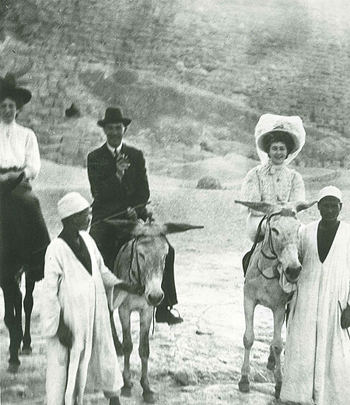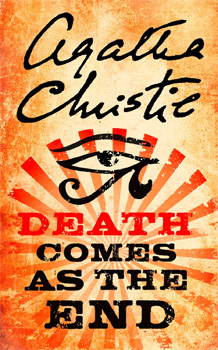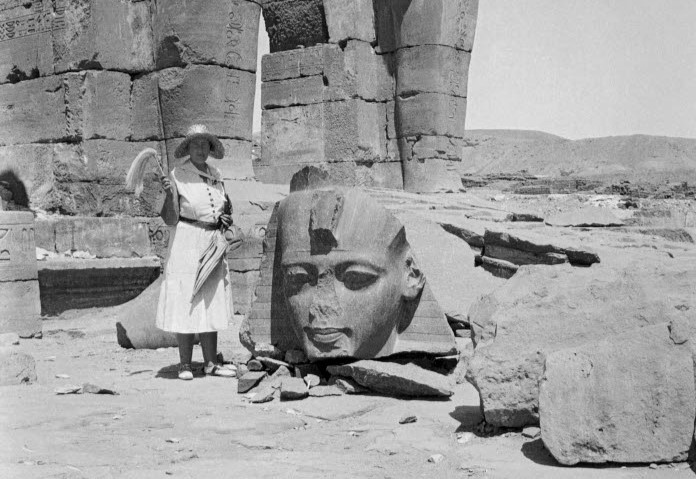Agatha Christie is world-renowned for her crime writing. Her countless mystery stories are packed with locked rooms, cracked mirrors and unreliable clocks. Trains, boats and islands provide the closed systems in which one of the characters is inevitably the murderer. Card games, hunting parties and casual vacations provide the perfect backdrop for an intricate series of killings that seem to happen in plain sight. A broken bottle, lost hairpin or careless remark by an innocent bystander is usually the clue towards deciphering the puzzle. Often the murderer has overdone it. In a mist of tampered evidence, walking and talking corpses and red herrings, the crime is always solved by clever thinking and common sense.
The investigators charged with unwinding the threads come in the form of characters as unlikely as they are stubborn. Most famous are the elderly spinster Miss Marple and the unimpeachable Belgian private detective (and true gentleman) Hercule Poirot. Occasionally, the authoress unscrupulously mocks herself in the form of the dubious personality of ‘the novelist’: clad in flowing robes, drunk and extravagant like Salome Otterbourne in Death on the Nile, or headstrong and apple-munching like Ariadne Oliver, good friend of Poirot.
But beside being a brilliant novelist, Christie was also the wife of an archaeologist. She met Max Mallowan on a trip to the site of Ur in 1930. After their subsequent marriage they worked in Syria and Iraq at places like Nineveh, Nimrud and Tell Brak. Christie participated in the archaeological work, cleaning and conserving objects, taking photographs and field notes. The sites she visited became a romantic source of inspiration for many of her detective stories. She even staged one in ancient Egypt (Death Comes as the End), with the help of friend and Egyptologist Stephen Glanville to get all the details right. Next to crime novels, she published a non-fiction account of her experience in Near Eastern archaeology, which is aptly called Come, Tell Me How You Live (‘tell’ being the Arabic word for a settlement mound).

An overview of Christie’s novels and non-fiction that relate to Egypt and the Near East:
Murder on the Orient Express (1934)
In operation since 1883 (and recently ended), the Orient Express was the mode of luxury travel for the wealthy classes at the time and the easiest way to reach Syria. Running from Paris to Istanbul, the coaches of the Compagnie Internationale des Wagons-Lits could contain the most unlikely set of passengers from different walks of life, which is indeed the case in this novel. When a snowdrift stops the train in eastern Europe, strange disturbances can be heard during the night. In the morning, a wealthy businessman is found dead in his bed with multiple stab-wounds, and Poirot sets to work…
The 1974 film adaptation contains a great set of characters except, unfortunately, Poirot himself (who is portrayed by Albert Finney as a combination of Charlie Chaplin and Hitler). My favourite Poirot personification David Suchet stars in the 2010 TV episode, which is (unlike the original story) much more concerned with the moral dilemma of this particular crime. There is even a casual adventure game made after the book in 2006, featuring the player as amateur sleuth who solves the crime with help from Poirot (modelled after Suchet).

Murder in Mesopotamia (1936)
Set on an archaeological excavation in Iraq, this story is narrated by the nurse of the wife of the excavation leader, although Poirot features in it. The archaeologist’s wife is murdered, and without spoiling anything, the solution to the crime shows the irony Christie was capable of. The details of the dighouse and excavation site well reflect her knowledge about archaeological matters. Imagine the authoress sitting on the roof terrace, looking out over the desert and the setting sun, conjuring up her detective stories, basing the dubious characters in her novels on the members of the excavation team.
In the 2002 TV adaptation, the role of the nurse is heavily reduced, and Captain Hastings (Poirot’s trusty sidekick) is made the uncle of one of the characters. Several details are changed and the episode is filmed in Tunisia.
 Death on the Nile (1937)
Death on the Nile (1937)
The first Agatha Christie novel I ever read, for obvious reasons. What is more romantic than a cruise on the Nile, when what appears to be a crime passionnel takes place? Beside the clever story, one must love the ancient sites that are visited, in a terribly nonsensical order, in the film and TV adaptations. Also, the hotels that feature in the films (Winter Palace in Luxor and the Old Cataract in Aswan) were the same hotels where Christie stayed and wrote her novels.
In the 1978 film, Peter Ustinov plays holidaying Poirot, which is an improvement on Albert Finney, but still not as marked a character as David Suchet. Jackie (Mia Farrow) is somewhat hysterical, but the rest of the cast is splendid, especially Angela Lansbury as extravagant novelist Salome Otterbourne, and Maggie Smith (Downton Abbey!) already sulking as Miss Bowers.
In this film, the honeymoon of the Doyles starts at the pyramids of Giza, after which the cruise departs from the Old Cataract Hotel at Aswan (800 km south of Cairo!). It then passes the temple of Karnak at Luxor (200 km north of Aswan) after turning to Abu Simbel (200 km south of Aswan). Of course this is perfectly legitimate artistic freedom, but so obviously wrong to anyone who has ever travelled in Egypt.
In the 2004 TV episode, several details are changed (although it is more romantic and less hysterical than the film adaptation), and we are treated to a different set of ancient locations: starting at the Winter Palace Hotel in Luxor, the party visits the temples of Luxor and Dendera and the Valley of the Kings.
Appointment with Death (1938)
In the cliffs of Petra in Jordan sits the corpse of a woman who was hated by all, apparently killed within plain sight. A very good story, which is much changed and slightly overdone in the 2008 TV episode (I haven’t seen the 1988 film yet). The film is set in Qumran, Palestine, while the TV episode is set on a dig in Syria, where an archaeologist is seeking the head of John the Baptist. It is too sensational to fit the original book, but don’t you love the actors! Tim Curry, Mark Gatiss (looking very young) and Elizabeth McGovern (from Downton Abbey) all feature alongside a grumpy David Suchet trotting through the desert in his good shoes, slapping about with a horsehair fly swatter.
 Death Comes as the End (1944)
Death Comes as the End (1944)
Set in ancient Egypt for once, this novel features the household of a priest on the West Bank at Thebes. A concubine is found murdered at the foot of a cliff. The sharp priest’s daughter goes out to investigate, and finds that envy and hatred lurk within her family. The story is based on the Heqanakht papyri, a series of letters from the Middle Kingdom that were translated for the Metropolitan Museum by Battiscombe Gunn. I found it cleverly written and very true to Egyptological form.
Come, Tell Me How You Live (1946)
In this work of non-fiction, Christie wittily describes her ventures into Syria and Iraq in the 1930s, accompanying her husband Max Mallowan on archaeological digs. Not the archaeology itself is dealt with, but her life around it, the trips and living conditions and the way in which a dig was conducted in those times. I found it very insightful, especially since certain things do not seem to have changed one bit. When I was assisting the Dutch excavations at Saqqara in 2010, our excavation leader wanted to reward the workmen with extra baksheesh if they made an interesting find. Not long after this statement, an obviously fake scarab was found. This is exactly what Christie describes in her book as well. A good reminder that the means may be modern, but the way in which a dig is conducted is slow to change.
“The lure of the past came up to grab me. To see a dagger slowly appearing, with its gold glint, through the sand was romantic. The carefulness of lifting pots and objects from the soil filled me with a longing to be an archaeologist myself.”
– Agatha Christie, An Autobiography (1984), p. 389.
See also: The Ancient Egypt film site

There are archaeologists (Frenchmen working at Susa) in “Death in the Clouds”
They Came to Baghdad